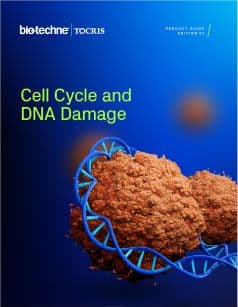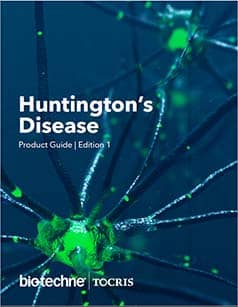DNA, RNA and Protein Synthesis
The syntheses of RNA (transcription), DNA and proteins (translation) are fundamental processes necessary for all life. Transcription begins by uncoiling a section of DNA that will be used as the template and is initiated by RNA polymerase binding to a promoter sequence.
DNA, RNA and Protein Synthesis Antagonists |
|
|---|---|
| Cat. No. | Product Name / Activity |
| 7894 | Auxinole |
| Auxin antagonist of TIR1/AFB receptors; also OsTIR1 inhibitor in auxin-inducible degron (AID) system | |
DNA, RNA and Protein Synthesis Modulators |
|
| Cat. No. | Product Name / Activity |
| 6460 | ABX 464 |
| HIV RNA splicing modulator | |
| 8063 | CHDI 113 |
| Potent HTT pre-RNA splicing modulator | |
| 7679 | RECTAS |
| IKBKAP pre-mRNA splicing modulator | |
| 7054 | T4 |
| Modulator of alternative polyadenylation; inhibits rod photoreceptor gene expression via Nr2e3 | |
DNA, RNA and Protein Synthesis Inhibitors |
|
| Cat. No. | Product Name / Activity |
| 4800 | 4EGI-1 |
| Inhibitor of eIF4E:eIF4G interaction | |
| 1229 | Actinomycin D |
| RNA polymerase inhibitor | |
| 4025 | α-Amanitin |
| Inhibitor of RNA polymerase II | |
| 1290 | Anisomycin |
| Protein synthesis inhibitor | |
| 5736 | Aphidicolin |
| DNA polymerase α, δ and ε inhibitor | |
| 6392 | B02 |
| RAD51 recombinase inhibitor | |
| 2981 | BIBR 1532 |
| Selective telomerase inhibitor | |
| 5417 | BMH 21 |
| RNA polymerase 1 inhibitor; also p53 pathway activator | |
| 6196 | Brequinar sodium |
| Potent and selective DHODH inhibitor | |
| 7457 | CAM 833 |
| Selective orthosteric inhibitor of the BRCA2-RAD51 interaction | |
| 2626 | Carboplatin |
| Inhibitor of DNA synthesis | |
| 2294 | Cordycepin |
| RNA synthesis inhibitor | |
| 7485 | Covidcil-19 |
| Binds to SARS-CoV-2 frameshifting element and reduces frameshifting efficiency | |
| 0970 | Cycloheximide |
| Inhibitor of protein synthesis | |
| 4520 | Cytarabine |
| Nucleoside analog; inhibits DNA replication | |
| 3917 | Daptomycin |
| Antibiotic; inhibits protein, DNA and RNA synthesis in gram-positive bacteria | |
| 1467 | Daunorubicin hydrochloride |
| RNA synthesis inhibitor | |
| 3857 | Dexrazoxane hydrochloride |
| Topoisomerase II inhibitor | |
| 7810 | eIF4A i28 |
| eIF4A inhibitor | |
| 7342 | Emetine dihydrochloride |
| RNA polymerase inhibitor; inhibits replication of a broad range of RNA and DNA viruses, including SARS-CoV-2 and Zika | |
| 3495 | Fludarabine |
| Purine analog; inhibits DNA synthesis | |
| 3257 | 5-Fluorouracil |
| Inhibits RNA and DNA synthesis | |
| 3259 | Gemcitabine hydrochloride |
| DNA synthesis inhibitor | |
| 1993 | Halofuginone hydrobromide |
| High affinity competitive prolyl-tRNA synthetase inhibitor | |
| 1416 | Homoharringtonine |
| Inhibitor of protein synthesis; antileukemic agent | |
| 7338 | K 22 |
| Inhibits coronavirus RNA replication; impairs double membrane vesicle (DMV) formation | |
| 6510 | LNT 1 |
| Potent flap endonuclease 1 (FEN1) inhibitor; induces DNA damage response | |
| 6819 | Mefloquine hydrochloride |
| Binds 80S ribosome and inhibits protein synthesis in P falciparum; also gap junction blocker | |
| 1489 | Mithramycin A |
| Inhibitor of DNA and RNA polymerase | |
| 3258 | Mitomycin C |
| Inhibitor of DNA synthesis | |
| 6359 | Nelarabine |
| Purine nuceloside analog; inhibits DNA synthesis | |
| 5340 | NSC 617145 |
| Werner syndrome helicase (WRN) inhibitor | |
| 2623 | Oxaliplatin |
| Inhibitor of DNA synthesis | |
| 6070 | Pladienolide B |
| mRNA splicing inhibitor; antitumor | |
| 7321 | Pritelivir |
| Potent and selective herpes simplex virus (HSV) helicase primase inhibitor | |
| 4089 | Puromycin dihydrochloride |
| Protein synthesis inhibitor | |
| 4501 | Ribavirin |
| Antiviral guanosine analog; blocks eIF4E activity | |
| 7760 | Selinexor |
| Selective exportin 1 (XPO1/CRM1) inhibitor | |
| 7554 | SSYA10-001 |
| Inhibits coronavirus helicase; blocks unwinding activity of Nsp13 and RNA synthesis | |
| 6884 | TC SL C5 |
| Metastasis-associated lung adenocarcinoma transcript 1 (Malat1) RNA inhibitor | |
| 5069 | Teriflunomide |
| Inhibitor of DHODH; active metabolite of Leflunomide | |
| 4309 | TPEN |
| RNA binding protein Lin28 inhibitor; cell-permeable Zn2+ chelator | |
| 3253 | Triptolide |
| Inhibits RNAPII-mediated transcription; antitumor, anti-inflammatory and immunosuppressive | |
| 3863 | Trovafloxacin mesylate |
| Antibiotic; inhibits bacterial DNA synthesis | |
| 7569 | Verdinexor |
| Selective exportin-1 (XPO1/CRM1) inhibitor | |
| 3787 | Viomycin |
| Antibiotic; inhibits bacterial DNA synthesis | |
| 4067 | YK 4-279 |
| Inhibitor of RNA helicase A (RHA) | |
| 6491 | YM 155 |
| RNA binding protein ILF3 inhibitor; survivin suppressor | |
DNA, RNA and Protein Synthesis Activators |
|
| Cat. No. | Product Name / Activity |
| 8825 | TAC |
| TERT activator | |
Other |
|
| Cat. No. | Product Name / Activity |
| 6602 | 1M7 |
| Reagent for RNA SHAPE-MaP chemistry | |
| 7376 | 2A3 |
| Reagent for RNA SHAPE-MaP experiments in vivo; cell permeable | |
| 3771 | Azithromycin |
| Antibiotic; inhibits 50S ribosomal subunit formation and elongation at transpeptidation | |
| 5015 | 5-BrdU |
| Synthetic thymidine analog; used for cell proliferation assays | |
| 8108 | CEP |
| Chemoproteomic reagent, clickable electrophilic purine for RNA binding profiling in live cells | |
| 4091 | Cyclophosphamide |
| Alkylating agent; chemotherapeutic | |
| 4090 | Doxycycline hyclate |
| Regulator for inducible gene expression systems; also broad-spectrum antibiotic and MMP inhibitor | |
| 7207 | 5-Ethynyl-2'-deoxyuridine |
| Thymidine analog for labeling DNA; can be linked to a fluorophore by click chemistry | |
| 7206 | 5-Ethynyluridine |
| Uridine analog, used for labeling RNA synthesis | |
| 8011 | FAI |
| Reagent for RNA SHAPE-MaP experiments in live cells | |
| 5075 | Harmine |
| Binds to the yjdF aptamer; activates riboswitch function; also DYRK1A inhibitor | |
| 6782 | Indisulam |
| Pre-mRNA splicing modulator; hCA XII inhibitor | |
| 5284 | trans-ISRIB |
| Integrated stress response (ISR) inhibitor | |
| 5185 | JTE 607 dihydrochloride |
| Active metabolite binds CPSF3; Pro-drug | |
| 7942 | Lac-Phe |
| Metabolite generated by cytosol nonspecific dipeptidase (CNDP2) during intense exercise | |
| 7586 | Molnupiravir |
| Prodrug of antiviral nucleoside analog; inhibits SARS-CoV, SARS-CoV-2 and MERS-CoV infection | |
| 7004 | NAI |
| Reagent for RNA SHAPE-MaP experiments in vivo; cell permeable | |
| 7974 | P3S |
| Reagent for modifying RNA at 2'-OH position, for SHAPE-MAP experiments | |
| 6862 | Psoralen-triethylene glycol azide |
| RNA conformation probe; reagent for COMRADES RNA platform | |
| 7916 | Risdiplam |
| Selective SMN2 gene splicing modifier | |
RNA, DNA and protein synthesis are fundamental processes necessary for all life.
RNA synthesis (transcription) begins by uncoiling a section of DNA that will be used as the template. RNA polymerase binds to a promoter sequence and initiates separation of the DNA double helix. Complementary ribonucleotides align and RNA polymerase catalyzes their polymerization. The newly synthesized RNA strand undergoes post-transcriptional processing before it leaves the nucleus.
Protein synthesis (translation) is the process of synthesizing a polypeptide chain from a mRNA template. Initiation factors trigger the small ribosomal subunit to bind to mRNA, allowing a tRNA molecule (which contains an amino acid) with an anticodon complementary to the mRNA initiation codon to bind. The large ribosomal subunit now binds and translation occurs. tRNA molecules sequentially bind to the complementary mRNA sequences and ribosomal enzymes catalyze the formation of peptide (amide) bonds.
DNA synthesis is a semiconservative process; each strand serves as a template for the synthesis of a new one. Helicase enzymes 'unwind' the DNA double helix, allowing DNA polymerase access to the polynucleotide chain. DNA polymerase cannot initiate de novo DNA synthesis - an RNA primer is required - and synthesis occurs in a 5' to 3' direction. DNA polymerases have 'proofreading' ability, which is essential to prevent mutations in the genome.
Literature for DNA, RNA and Protein Synthesis
Tocris offers the following scientific literature for DNA, RNA and Protein Synthesis to showcase our products. We invite you to request* your copy today!
*Please note that Tocris will only send literature to established scientific business / institute addresses.
Cell Cycle and DNA Damage Research Product Guide
This product guide provides a review of the cell cycle and DNA damage research area and lists over 150 products, including research tools for:
- Cell Cycle and Mitosis
- DNA Damage Repair
- Targeted Protein Degradation
- Ubiquitin Proteasome Pathway
- Chemotherapy Targets
Huntington's Disease Research Product Guide
This product guide provides a background to Huntington's disease research and lists around 100 products for the study of:
- Somatic Instability
- Proteolysis and Inclusion Bodies
- Transcriptional Dysregulation
- Mitochondrial Dysfunction
- Nuclear-Cytoplasmic Transport Interference
- Excitotoxicity
- Stem Cells

